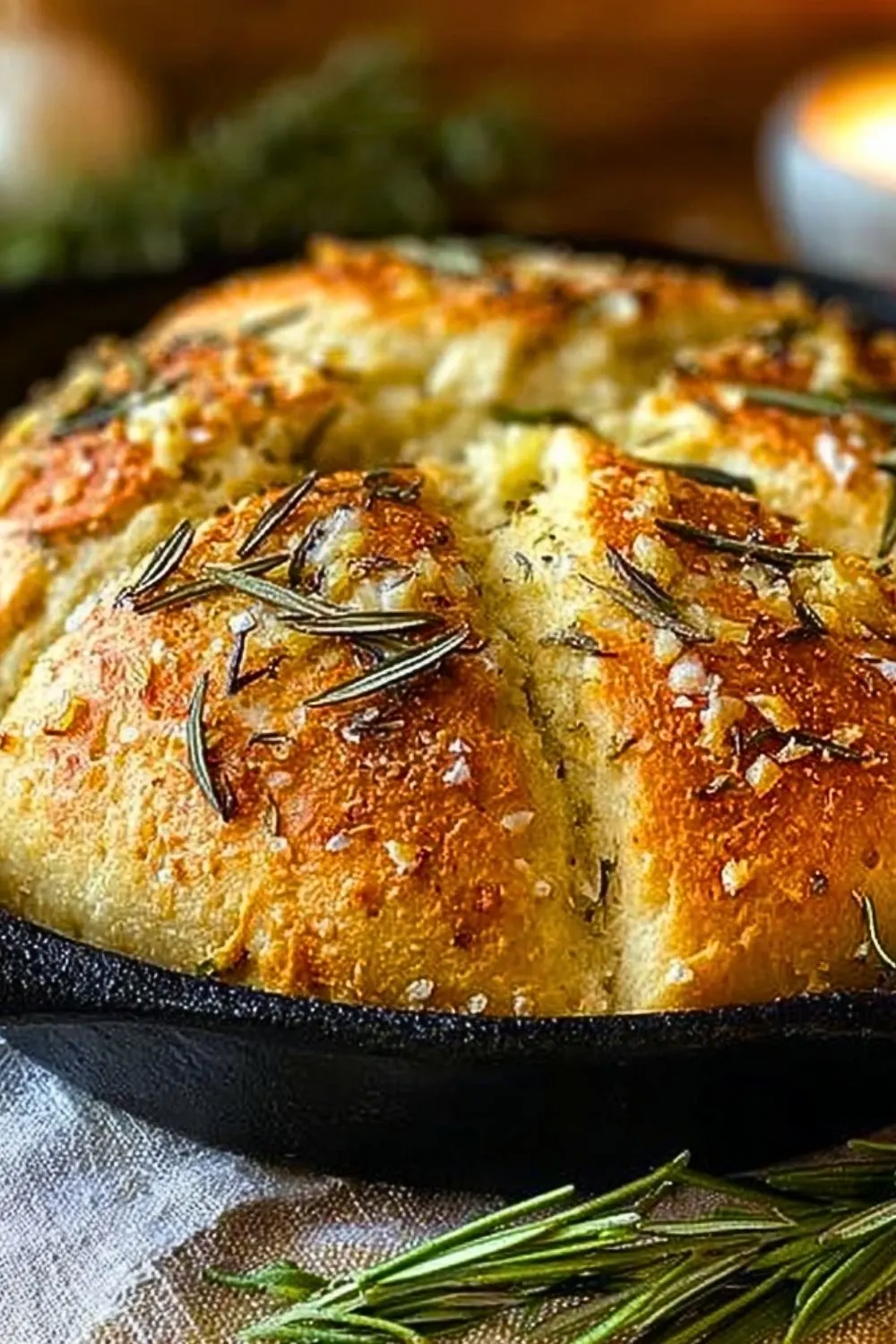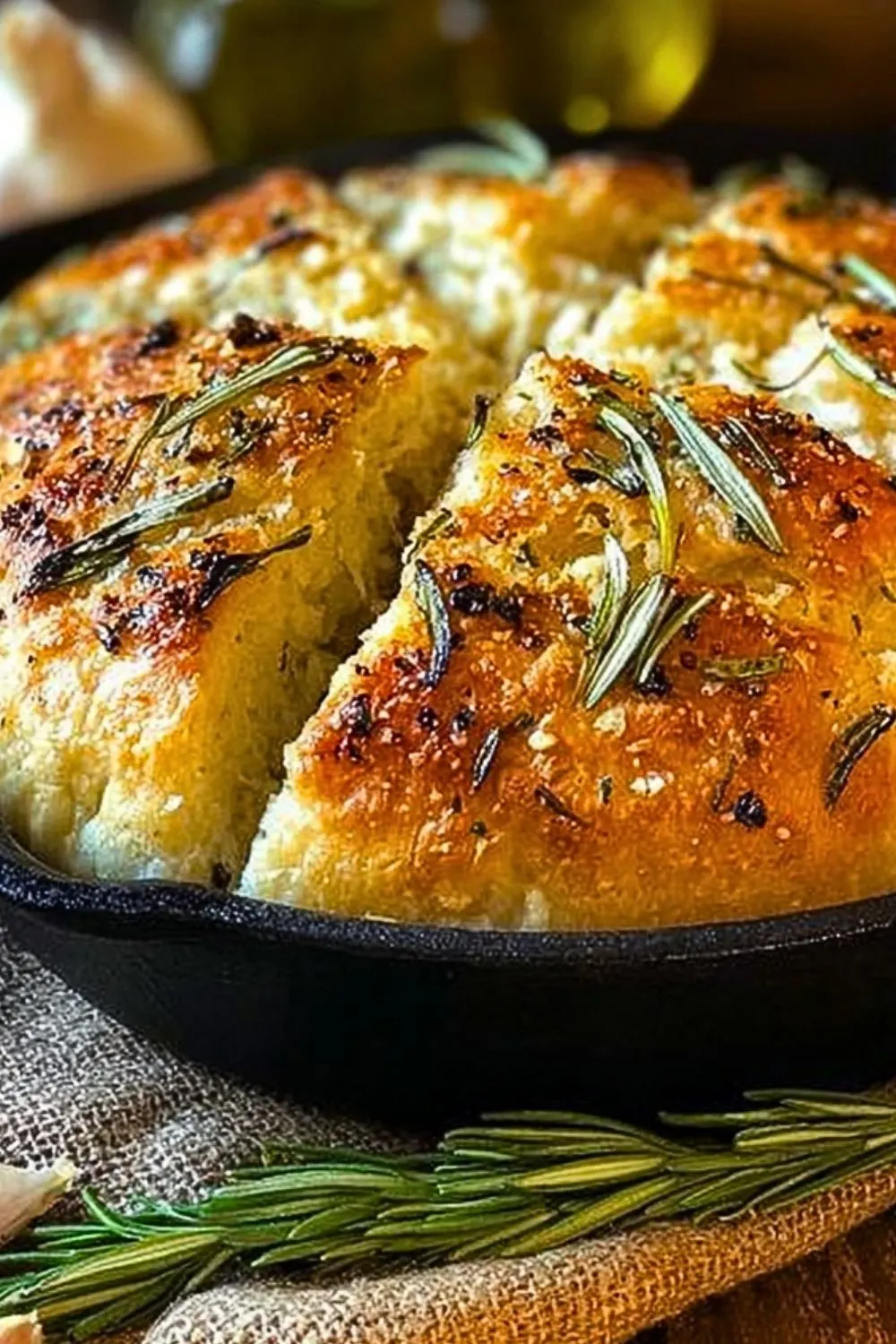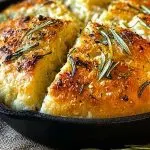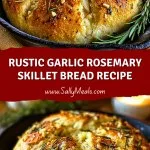Golden, crusty, and impossibly fragrant—Rustic Garlic Rosemary Skillet Bread is the kind of bread that stops conversations as it hits the table. Baked right in a cast-iron skillet, it boasts a beautifully crisp outer crust while the inside stays pillowy and moist. Fresh rosemary adds an earthy note, garlic gives it depth, and a light dusting of sea salt and parmesan seals the deal for a loaf that’s as much a centerpiece as it is a side dish.

This recipe doesn’t just make bread—it brings warmth to the table. Whether you’re serving it with a cozy soup, fresh pasta, or simply tearing into it with a knob of butter, this skillet bread delivers that homemade charm with minimal effort. No fancy tools or complicated techniques, just simple ingredients coming together in a deeply satisfying way.
Why You’ll Love This Rustic Garlic Rosemary Skillet Bread
- Crispy outside, fluffy inside – Thanks to the magic of cast-iron baking.
- No kneading required – A beginner-friendly, mix-and-rise method.
- Packed with flavor – Fresh rosemary, minced garlic, and sea salt infuse every bite.
- Versatile – Serve it with soups, salads, cheese boards, or as a sandwich base.
- Crowd-pleaser – Perfect for gatherings, dinner parties, or just elevating your weeknight meal.
Preparation Phase & Tools to Use (Essential Tools and the Importance of Each Tool)
Before diving into this incredibly aromatic Rustic Garlic Rosemary Skillet Bread, it’s important to set up your kitchen for success. Here’s what you’ll need—and why each item matters.
- Cast-Iron Skillet (10-12 inch): This is non-negotiable for that signature crisp crust. The heat retention of cast iron gives the bread its golden, evenly baked exterior while keeping the inside tender.
- Mixing Bowl (Large): You'll need a large bowl to mix and allow the dough to rise. A deep one gives the dough space to double without sticking to a cover.
- Wooden Spoon or Danish Dough Whisk: Perfect for combining ingredients thoroughly without overworking the dough. The dough is shaggy and sticky, so a spoon is your best friend here.
- Clean Kitchen Towel or Plastic Wrap: Essential for covering the dough during its rise. This helps maintain warmth and moisture for proper fermentation.
- Bench Scraper or Spatula: Useful when transferring the dough into the skillet—especially since this is a no-knead, high-hydration dough.
- Pastry Brush (optional): To brush olive oil or melted butter on top before baking for an extra golden finish.
- Sharp Knife or Scoring Blade: For slashing the dough just before baking. This creates beautiful expansion and artisan-style looks.
Preparation Tips
- Use warm water (around 100–110°F) to activate the yeast properly without killing it.
- Don’t overmix. The dough should be sticky and shaggy—this is normal and part of the no-knead method.
- Let it rise in a warm place. The dough needs time and warmth to develop flavor and structure. An oven (turned off) with the light on works well.
- Grease the skillet generously with olive oil. This prevents sticking and contributes to that crusty bottom.
- Score the dough right before baking—it helps the bread expand properly and look rustic.
- Add toppings like rosemary sprigs, sea salt, or grated parmesan before baking for a gourmet finish.
Ingredients for This Rustic Garlic Rosemary Skillet Bread
This recipe keeps things simple and rustic, with ingredients you likely already have in your pantry and fridge. Here's everything you’ll need:
- 3 cups all-purpose flour – Provides the structure and body for the bread.
- 2 teaspoons instant yeast – Helps the dough rise quickly and evenly.
- 1 ½ teaspoons sea salt – Enhances the flavor and balances the herbs.
- 1 ¼ cups warm water (100–110°F) – Activates the yeast and brings the dough together.
- 3 tablespoons olive oil (plus extra for greasing) – Adds richness and promotes a crispy crust.
- 2 garlic cloves, minced – Infuses the dough with bold, savory flavor.
- 1 tablespoon fresh rosemary, finely chopped – Earthy, aromatic, and deeply flavorful.
- 1 tablespoon grated parmesan cheese (optional) – Sprinkled on top for a golden, savory finish.
- Extra rosemary sprigs (for garnish) – For presentation and added aroma.
- Coarse sea salt (for topping) – A final touch for flavor and crunch.
Tip: You can substitute active dry yeast for instant—just dissolve it in the warm water and let it sit for 5–10 minutes before adding to the flour.

Step 1: Mix the Dough
In a large mixing bowl, combine the flour, instant yeast, and sea salt. Stir well to distribute the dry ingredients evenly. Add the warm water, olive oil, minced garlic, and chopped rosemary. Use a wooden spoon or dough whisk to mix until a sticky, shaggy dough forms. Don’t overmix—just make sure there are no dry flour pockets.
Step 2: First Rise
Cover the bowl with a clean kitchen towel or plastic wrap. Let the dough rest in a warm, draft-free area for 1 to 2 hours, or until it has doubled in size. You can also do a slower rise overnight in the fridge for deeper flavor.
Step 3: Prepare the Skillet
Generously grease a cast-iron skillet (10–12 inch) with olive oil. This will prevent sticking and give the bottom of the bread a crisp, golden crust.
Step 4: Transfer the Dough
Use a spatula or your hands (lightly oiled or floured) to gently scrape the dough from the bowl into the prepared skillet. Try not to deflate it too much—handle it carefully to keep the air bubbles intact.
Step 5: Second Rise
Cover the skillet loosely with a towel or plastic wrap and let the dough rise again for about 30 to 40 minutes, until slightly puffy. Meanwhile, preheat your oven to 400°F (200°C).
Step 6: Score and Top
Just before baking, use a sharp knife to score a few slashes across the top of the dough (this helps it expand while baking). Drizzle a little more olive oil on top, then sprinkle with parmesan cheese, coarse sea salt, and extra rosemary sprigs.
Step 7: Bake
Place the skillet in the preheated oven and bake for 25–30 minutes, or until the bread is golden brown and sounds hollow when tapped. If the top is browning too fast, tent it loosely with foil.
Step 8: Cool and Serve
Remove the bread from the oven and allow it to cool in the skillet for at least 10–15 minutes before slicing. This helps set the structure and intensifies the flavor.
Notes
- Overnight Rise Option: For a richer, more developed flavor, let the dough rise in the fridge overnight instead of at room temperature. Just bring it to room temp before baking.
- Gluten-Free Version: Substitute with a reliable 1:1 gluten-free flour blend. Texture may vary slightly, but it still works well.
- Make It Vegan: Simply skip the parmesan or use a dairy-free alternative—this bread is naturally dairy- and egg-free otherwise.
Watch Out for These Mistakes While Cooking
- Using cold water with yeast: Yeast needs warm water (around 100–110°F) to activate. Cold water won’t trigger fermentation, and hot water might kill it.
- Underproofing or overproofing: If your dough hasn't risen enough, it’ll be dense. If it rises too much, it might collapse or turn overly airy with a tough crust.
- Not scoring the dough: Skipping this step can lead to uneven expansion or a misshapen loaf. It’s also key to that rustic artisan look.
- Adding too much flour: The dough should be sticky and soft. Resist the urge to keep adding flour—it’s supposed to feel wet.
- Not preheating the oven: A hot oven ensures the bread rises quickly and gets that perfect golden crust.
- Overbaking: Cast iron retains heat, so watch the last few minutes of baking. Overbaking dries out the inside.
- Skipping the oil in the skillet: This will cause the bread to stick and ruin that crispy base.
- Cutting while too hot: Let the bread rest for 10–15 minutes before slicing. Cutting too soon lets steam escape and affects texture.
What to Serve With Rustic Garlic Rosemary Skillet Bread?
This bread is more than a side—it’s a statement. Its garlicky, herby richness pairs beautifully with a variety of dishes, from rustic soups to elegant appetizers.
8 Recommendations
- Creamy Tomato Basil Soup
A classic combo. The bread’s crusty edges are perfect for dunking into a rich, velvety tomato base. - Olive Tapenade or Artichoke Dip
Set out warm slices with a savory spread for an easy appetizer or snack board. - Hearty Beef Stew
Soak up all the flavorful broth with a thick hunk of skillet bread—comfort food at its best. - Baked Brie with Honey and Nuts
Level up your cheese platter with this bread on the side. The rosemary and garlic cut through the sweetness beautifully. - Spaghetti Bolognese or Creamy Alfredo
Use the bread to mop up every last bit of sauce. It holds up well and adds a crunchy texture contrast. - Grilled Vegetables and Hummus
For a lighter pairing, serve it alongside charred zucchini, peppers, and a creamy dip. - Shakshuka
This tomato and egg dish is made for bread like this—scoop, dip, and enjoy. - Simple Herb Butter or Olive Oil with Balsamic Vinegar
Let the bread shine with minimal effort. Warm slices with a side of seasoned oil are always a hit.
Storage Instructions
Rustic Garlic Rosemary Skillet Bread stores surprisingly well—though it rarely lasts long! Here’s how to keep it fresh:
- Room Temperature: Store leftover bread in an airtight container or wrap it in foil. It will stay fresh for up to 2 days at room temp. Avoid storing it in the fridge, as that can dry it out faster.
- Freezer: Wrap the cooled bread (whole or sliced) tightly in plastic wrap, then foil. Place it in a freezer-safe bag and freeze for up to 2 months. Reheat in the oven at 350°F until warmed through.
- To Reheat: Warm slices in a toaster oven or skillet with a little butter or olive oil. You can also wrap the whole loaf in foil and reheat at 350°F for 10–12 minutes.
Estimated Nutrition (Per Slice, based on 10 slices)
- Calories: 185
- Carbohydrates: 28g
- Protein: 4g
- Fat: 6g
- Saturated Fat: 1g
- Unsaturated Fat: 5g
- Cholesterol: 0mg
- Sodium: 280mg
- Fiber: 1g
- Sugar: 0g
- Trans Fat: 0g
Note: These values are estimates and can vary based on specific ingredients used (like added parmesan or more olive oil).
Frequently Asked Questions
1. Can I use dried rosemary instead of fresh?
Yes, you can. Use about 1 teaspoon of dried rosemary in place of 1 tablespoon fresh. Dried herbs are more concentrated, so a little goes a long way.
2. What if I don’t have a cast-iron skillet?
A heavy-duty oven-safe baking dish or Dutch oven can work. Just be sure to grease it well, and note that crust texture may differ slightly.
3. Can I make the dough ahead of time?
Absolutely. Let the dough rise in the fridge overnight for even more flavor. Bring it to room temperature before the second rise and baking.
4. Is this bread vegan?
Yes, it’s naturally vegan if you skip the parmesan cheese or use a plant-based alternative.
5. Why is my dough so sticky?
It’s supposed to be! This is a high-hydration, no-knead dough. Resist adding too much flour or it will become dense. Lightly oil or flour your hands if needed.
6. Can I add other herbs or toppings?
Definitely. Try adding thyme, oregano, or roasted garlic. You can also sprinkle in cheeses like feta, or even sun-dried tomatoes for a twist.
7. How do I know when the bread is done?
It should be golden brown on top and sound hollow when tapped. You can also insert a thermometer into the center—it should read about 190–200°F.
8. Can I double the recipe?
Yes, but you’ll need a larger skillet (or divide into two). Doubling the recipe will also slightly increase baking time—watch for doneness.
Conclusion
Rustic Garlic Rosemary Skillet Bread is the ultimate way to bring warmth, flavor, and comfort to your table without breaking a sweat. With just a few pantry staples and fresh herbs, you’ll create a golden, crusty loaf that impresses everyone—whether it’s your dinner guests or just yourself on a cozy night in. From its beautifully blistered crust to the garlicky, herby aroma, this bread delivers artisan flavor with zero fuss. Once you try it, you’ll find yourself making it on repeat.

Rustic Garlic Rosemary Skillet Bread Recipe
- Prep Time: 10 minutes
- Cook Time: 30 minutes
- Total Time: 2 hours
- Yield: 1 loaf (8–10 slices) 1x
- Category: Bread
- Method: Baking
- Cuisine: Rustic, Mediterranean
Description
Crispy on the outside, soft and pillowy on the inside—this Rustic Garlic Rosemary Skillet Bread is a quick and easy recipe that delivers artisan bakery vibes right from your kitchen. Perfect for cozy dinners, holiday meals, or as an everyday side, this savory bread is infused with garlic, fresh rosemary, and topped with flaky sea salt and parmesan for that wow factor. Whether you’re looking for a quick bread for dinner, a rustic appetizer, or delicious breakfast ideas, this loaf has you covered. No kneading required and minimal cleanup—just real, rustic flavor.
Ingredients
3 cups all-purpose flour
2 teaspoons instant yeast
1 ½ teaspoons sea salt
1 ¼ cups warm water
3 tablespoons olive oil
2 garlic cloves minced
1 tablespoon fresh rosemary finely chopped
1 tablespoon grated parmesan cheese (optional)
Extra rosemary sprigs for garnish
Coarse sea salt for topping
Instructions
1. In a large bowl, mix together flour, yeast, and salt. Stir to combine.
2. Add warm water, olive oil, minced garlic, and chopped rosemary. Stir until a sticky, shaggy dough forms.
3. Cover the bowl with a towel or plastic wrap and let it rise in a warm place for 1–2 hours, until doubled.
4. Grease a cast-iron skillet with olive oil.
5. Gently transfer the dough into the skillet without deflating it.
6. Let the dough rise again for 30–40 minutes while preheating the oven to 400°F (200°C).
7. Score the top with a sharp knife. Drizzle more olive oil and sprinkle parmesan, rosemary, and coarse sea salt.
8. Bake for 25–30 minutes until golden brown and crusty.
9. Let it cool in the skillet for 10–15 minutes before slicing and serving.
Notes
For a deeper flavor, let the dough rise overnight in the fridge and bring to room temperature before baking.
Don’t overwork the dough—it’s meant to be sticky. Too much flour will toughen it.
If you don’t have a cast-iron skillet, a Dutch oven or heavy ceramic baking dish will also work.
Nutrition
- Serving Size: 1 slice
- Calories: 185
- Sugar: 0g
- Sodium: 280mg
- Fat: 6g
- Saturated Fat: 1g
- Unsaturated Fat: 5g
- Trans Fat: 0g
- Carbohydrates: 28g
- Fiber: 1g
- Protein: 4g
- Cholesterol: 0mg
Keywords: skillet bread, rosemary garlic bread, easy dinner bread, rustic bread, no-knead bread

